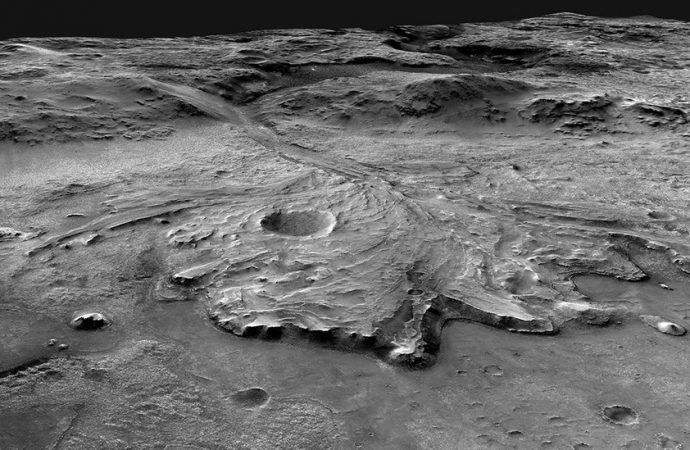Billions of years ago, the view from the edge of Jezero crater would have been “spectacular.”
Source: The Atlantic
Millions of miles away, on the surface of Mars, inside an enormous crater, a little NASA rover is taking some pictures. The view is quite stunning there—miles of undisturbed cinnamon terrain scattered with pebbles and boulders, with silky dunes where the craggy bedrock doesn’t peek through. But when the rover, named Perseverance, sent the photos back home from the crater, known as Jezero, scientists saw something more.
The arrangement of the sediment? It resembled a certain familiar landscape on Earth. Those boulders? A strong current had carried them in. Jezero, scientists could now see, wasn’t always dry and desolate. It was once a lake. The Perseverance rover was roaming what used to be a delta, where a small river met calm waters. A few billion years ago, the ground beneath its tires might have been sloshing with water.
On Earth, when a river pours into a lake, it carries grains of silt with it. Over time, that sediment builds up in layers that fan out from a narrow point where the running water meets the still. Observations from previous spacecraft missions, orbiting Mars from above, had shown something similar on the red planet’s surface, so scientists already suspected that Jezero crater, formed after a meteor impact, had been filled in with water. But they couldn’t be sure until Perseverance was there, snapping pictures like a mesmerized tourist. Here was history, the ancient ruins of Mars. The rover had looked out across the quiet terrain and observed not a barren wasteland, but a lost oasis.
The close-up photographs helped scientists conclude that the sediment—based on the thickness of its layers, and the way they slope—was indeed likely shaped by flowing water, not smoothed by wind or other geological processes. The researchers can even identify past weather events as transient as flash flooding: The boulders strewn across the lake bed, some estimated to weigh several tons, are embedded in the top layers of sediment, which suggests that they originated outside the crater. They must have been carried on waters strong enough to dislodge them and then take them downstream. But the environment wasn’t always so chaotic. Beneath these boulders lie layers of fine sediment, which suggests that, before the bombardment, a gentle river fed the basin.

About 3.7 billion years ago, Mars was surreally Earthlike—warm, with a thick atmosphere. What would Jezero have looked like then? For that, I asked Briony Horgan, a planetary-science professor at Purdue University and a Perseverance scientist who led the selection of Jezero crater as the mission’s destination. Horgan has daydreamed about what it might be like to stand near Jezero’s river delta and gaze out at the lake. The basin would be surrounded on all sides by dark mountains—the crater rim. The rock would slope down toward the water, gradually giving way to sandy white beaches. In moments without flooding, the water would be calm, gently lapping at the shore. Maybe a slight breeze would kick up some waves. The sky, protected by an atmosphere that has since been stripped away, would be a marvelous blue. “It would have been really spectacular,” Horgan said.
Somewhere along the way, the climate on Mars shifted drastically, and the planet transformed into the freezing, dusty world we see today. The sound of lapping waves has been replaced by the whirring noise of rovers. Scientists don’t know yet exactly what happened. But the researchers working on the Perseverance mission hope to find some answers inside that crater. An ancient lake bed is a fantastic place to look for evidence of fossilized microbes, and the Perseverance rover will spend its time on Mars collecting rock samples into tubes and storing them away so that future spacecraft missions, years from now, can bring them home to Earth.
Someday, like other rovers before it, Perseverance will itself become part of the scenery, as motionless as one of the boulders along the dried-up delta, sitting beneath the Martian clouds. Oh yes, Mars still has clouds—beautiful, wispy clouds made of ice. Billions of years from now, Earth’s own lakes and seas will vanish, boiled away by a sun growing hotter in its old age. Will any clouds stick around, casting shadows over our own desolate ruins?
Source: The Atlantic

































Leave a Comment
You must be logged in to post a comment.